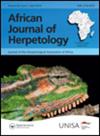来自南非朗格班威格和库珀洞穴化石遗址的一个新的无头猿家族
IF 0.9
4区 生物学
Q2 Agricultural and Biological Sciences
引用次数: 0
摘要
摘要:在南非的两个地理位置和时间上完全不同的化石地点,即Langebaanweg(西南开普)的早上新世(5.1 Ma)化石地点和Cooper 's Cave D(北部省),其历史约为1.38 Ma。化石ilia似乎代表了一种已经灭绝的无尾猿属,它在非洲南部生存了数百万年,有一种以前没有记载的运动方式,可能还有非凡的跳跃能力。相对于现存的无脊椎动物,化石髂骨表现出一系列独特的特征,包括髋臼、背突、轴腹脊和背嵴;这些特征可以促进和稳定跳跃。感谢DSI-NRF古科学卓越中心86073基金对本研究的支持。TM得到了南非国家研究基金会的财政支持。非常感谢CAF CT扫描设施(Stellenbosch大学)的Muofhe Tshibalanganda提供的大量帮助和支持。披露声明作者未报告潜在的利益冲突。本文章由计算机程序翻译,如有差异,请以英文原文为准。
A new anuran family from the fossil sites of Langebaanweg and Cooper’s Cave, South Africa
ABSTRACTEnigmatic frog ilia were recovered from two geographically and temporally disparate fossil sites in South Africa, namely the Early Pliocene (5.1 Ma) fossil site of Langebaanweg (south-western Cape), and Cooper’s Cave D (Northern province), which dates to around 1.38 Ma. The fossil ilia appear to represent an extinct anuran genus that subsisted in southern Africa over several million years, had a previously undocumented mode of locomotion, and possibly exceptional jumping ability. Relative to extant anurans, the fossil ilia show a unique suite of characteristics pertaining to the acetabulum, dorsal protuberance, ventral ridge of the shaft, and dorsal crest; features which would have facilitated and stabilised jumping.KEYWORDS: LangebaanwegCooper’s Caveiliummicrofaunaanuran AcknowledgementsThe support of the GENUS DSI-NRF Centre of Excellence in Palaeosciences Grant 86073 towards this research is gratefully acknowledged. TM received financial support from the National Research Foundation of South Africa. Many thanks to Muofhe Tshibalanganda at the CAF CT scan facility (Stellenbosch University) for much assistance and support.Disclosure statementNo potential conflict of interest was reported by the author(s).
求助全文
通过发布文献求助,成功后即可免费获取论文全文。
去求助
来源期刊
CiteScore
2.60
自引率
6.70%
发文量
0
审稿时长
>12 weeks
期刊介绍:
African Journal of Herpetology (AJH) serves as an outlet for original research on the biology of African amphibians and reptiles. AJH is an interdisciplinary journal that publishes original articles and reviews from diverse fields and disciplines, such as conservation, phylogenetics, evolution, systematics, performance, physiology, ecology, behavioural ecology, ethology, and morphology.
The Journal publishes two issues a year. There are no page charges .

 求助内容:
求助内容: 应助结果提醒方式:
应助结果提醒方式:


